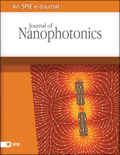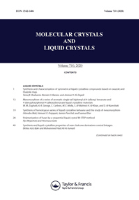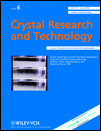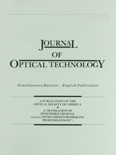
Liquid Crystals Today
Scope & Guideline
Pioneering Discoveries in Materials Chemistry
Introduction
Aims and Scopes
- Fundamental Research in Liquid Crystals:
The journal showcases research that delves into the fundamental properties of liquid crystals, including their molecular structure, phase transitions, and unique optical characteristics. - Applications of Liquid Crystals:
It highlights practical applications of liquid crystals in technology, such as in display technologies, photonics, and sensors, emphasizing their utility in modern devices. - Interdisciplinary Approaches:
The journal encourages interdisciplinary research that connects liquid crystal science with fields such as materials science, physics, and engineering, fostering innovative applications. - Public Engagement and Education:
There is a noticeable emphasis on public engagement initiatives and educational outreach related to liquid crystal science, reflecting a commitment to disseminating knowledge beyond the academic community. - Historical Perspectives:
The journal also reflects on the historical context and evolution of liquid crystal research, providing insights into past developments and their implications for current studies.
Trending and Emerging
- Topological and Soliton Phenomena:
There is a growing focus on topological solitons and related phenomena, highlighting the significance of these structures in understanding liquid crystal dynamics and their potential applications in advanced materials. - Active Liquid Crystal Systems:
Research in active liquid crystals, which respond dynamically to external stimuli, is gaining traction. This theme is crucial for developing smart materials and devices that can adapt to changing conditions. - Liquid Crystal Plasmonics:
The intersection of liquid crystals and plasmonics is emerging as a significant area of interest, indicating potential applications in photonic devices and sensors that utilize the unique properties of both fields. - Public Engagement Initiatives:
An increased emphasis on public engagement and outreach in liquid crystal science reflects a broader trend towards making scientific research accessible and relevant to the general public. - Interdisciplinary Research Collaborations:
There is a noticeable increase in interdisciplinary collaborations, merging liquid crystal research with fields such as biology, nanotechnology, and materials science, showcasing the versatility and relevance of liquid crystals in diverse applications.
Declining or Waning
- Classical Liquid Crystal Theory:
Research focused on classical theories of liquid crystal behavior has become less frequent, possibly due to the emergence of more complex and novel systems that require advanced theoretical frameworks. - Traditional Display Technologies:
Papers centered around conventional liquid crystal display (LCD) technologies are appearing less often, as the field evolves towards more innovative display solutions such as OLEDs and microLEDs. - Obituaries and Historical Accounts:
While obituaries and historical accounts have their place, their frequency seems to be waning, suggesting a potential shift towards more forward-looking research rather than retrospective reflections. - Basic Characterization Techniques:
There is a noticeable decrease in publications focused solely on basic characterization techniques of liquid crystals, as researchers are increasingly integrating advanced methodologies and interdisciplinary approaches. - Simple Experimental Studies:
Studies that present straightforward experimental findings without substantial theoretical or practical implications are becoming less common, indicating a trend towards more comprehensive and impactful research.
Similar Journals

Journal of Nanophotonics
Advancing Photonics Through Innovative ResearchThe Journal of Nanophotonics, published by SPIE-SOC Photo-Optical Instrumentation Engineers, is an esteemed platform dedicated to advancing the field of nanotechnology through pioneering research in photonics. Since its inception in 2007, this journal has become instrumental in disseminating innovative findings and fostering collaborative discussions, especially in the domains of Condensed Matter Physics, Electronic, Optical and Magnetic Materials, and Nanoscience and Nanotechnology. Currently ranked within the Q3 category across these fields, it serves as a vital resource for academics, industry professionals, and students keen on exploring the multifaceted applications and implications of nanophotonic technologies. With its convergence set to continue until 2024, the journal offers a non-open-access model, ensuring rigorous peer-review standards and high-quality publications that contribute to the global body of knowledge.

MOLECULAR CRYSTALS AND LIQUID CRYSTALS
Advancing Knowledge in Crystalline FrontiersMOLECULAR CRYSTALS AND LIQUID CRYSTALS is a distinguished journal published by Taylor & Francis Ltd, dedicated to the comprehensive examination of the structural and physical properties of molecular crystals and liquid crystals, with applications spanning fields such as chemistry, materials science, and condensed matter physics. Established in 1972, this journal has carved out a niche in the academic landscape despite facing recent challenges, as reflected in its current quartile rankings of Q4 across multiple categories in 2023. The journal not only serves as a platform for groundbreaking research but also invites contributions that further explore the intricate relationships between molecular organization and material properties, thereby advancing our understanding of these fascinating substances. With a commitment to fostering scientific dialogue, MOLECULAR CRYSTALS AND LIQUID CRYSTALS aims to reach a broad audience of researchers, professionals, and students, providing insights that are pivotal in driving innovation in materials research.

CRYSTAL RESEARCH AND TECHNOLOGY
Fostering Collaboration in Crystal ResearchCRYSTAL RESEARCH AND TECHNOLOGY, published by WILEY-V C H VERLAG GMBH, is a distinguished journal in the fields of Chemistry, Condensed Matter Physics, and Materials Science, with over five decades of continuous publication from 1966 to 2024. With its ISSN 0232-1300 and E-ISSN 1521-4079, the journal serves as a crucial platform for disseminating significant research findings, theoretical advances, and technological innovations related to crystal growth, structure, and properties. Holding a Category Quartile ranking of Q3 in the 2023 assessments across its disciplines, CRYSTAL RESEARCH AND TECHNOLOGY is recognized for its contribution to the scientific community, making it an essential resource for researchers, professionals, and students alike. While this journal is not open access, its robust publishing framework ensures that high-quality peer-reviewed articles remain accessible to a global audience. The importance of this journal lies in its commitment to advancing knowledge and fostering collaborations in crystallography and related fields.

JOURNAL OF OPTICAL TECHNOLOGY
Connecting Ideas in Optical TechnologyJOURNAL OF OPTICAL TECHNOLOGY, published by the Optica Publishing Group, serves as a vital resource for researchers and professionals in the fields of optical technology and related disciplines. Established with a commitment to advancing knowledge, this journal spans a broad spectrum of topics, including applied mathematics, atomic and molecular physics, and various engineering disciplines, with a converged publication period from 1995 to 2024. Although it currently holds a Q4 ranking across multiple categories in 2023, it is an important platform for innovative research ideas in a rapidly evolving field. The absence of Open Access may guide readers to explore alternative access options through institutional subscriptions. The journal’s ISSN is 1070-9762 and its E-ISSN is 1091-0786, ensuring accessibility for a global audience. As a publication aimed at fostering scholarly communication, it invites contributions that highlight emerging trends and novel developments in optical technology, catering to a multifaceted audience of researchers, professionals, and students.

OPTICAL MATERIALS
Transforming Ideas into Optical SolutionsOPTICAL MATERIALS is a peer-reviewed journal published by Elsevier, focusing on the intricate field of optical materials within various scientific domains including atomic and molecular physics, electronic engineering, and chemistry. With an impact factor indicative of its relevance, it ranks in the Q2 category across multiple areas such as Electrical and Electronic Engineering, and Inorganic Chemistry, highlighting its critical position in advancing research and innovation. Established in 1992 and continuing its contribution until 2024, this journal serves as a vital resource for researchers and professionals aiming to disseminate significant findings in material sciences, particularly those related to optical properties and applications. While it does not offer open access, the journal remains essential for academia and industry alike, ensuring the continued exchange of valuable knowledge in this rapidly evolving field.

Photonics Letters of Poland
Connecting Research with Real-World ApplicationsPhotonics Letters of Poland is a prominent journal dedicated to the field of photonics, published by the Photonics Society of Poland. With an ISSN of 2080-2242, the journal aims to foster knowledge and innovation within electronic, optical, and magnetic materials. Although it currently holds a Q4 classification in its category and is ranked in the 21st percentile, it serves as an essential platform for researchers and practitioners to share their findings and advancements. The journal covers a range of topics from foundational research to applied science, highlighting advancements in photonics technologies and their applications. Operating from Warsaw University of Technology, the journal promotes open access to knowledge while ensuring rigorous peer review standards. With its coverage spanning from 2009 to 2024, Photonics Letters of Poland represents a vital contribution to ongoing research within the field, making it indispensable for students, professionals, and academics looking to stay attuned to emerging trends and developments in photonics.

Chinese Journal of Liquid Crystals and Displays
Unveiling Breakthroughs in Optical and Magnetic MaterialsThe Chinese Journal of Liquid Crystals and Displays, published by SCIENCE PRESS, serves as a vital platform for researchers and professionals in the fields of electronic, optical, and magnetic materials as well as instrumentation and signal processing. With an ISSN of 1007-2780 and an E-ISSN of 2097-3217, this journal offers a unique perspective on advancements in liquid crystal technology and display innovations, reflecting the dynamic growth of this area of study since its convergence in 2015 through to 2024. Despite currently occupying a Q4 quartile ranking in multiple categories, researchers and industry practitioners will benefit from its publication of cutting-edge research, comprehensive reviews, and insightful discussions. Although not an open-access journal, this publication remains essential for those seeking to expand their knowledge and stay abreast of emerging trends in liquid crystals and display technologies, particularly from a Chinese perspective.

JOURNAL OF OPTOELECTRONICS AND ADVANCED MATERIALS
Illuminating the Path of Scientific Discovery in OptoelectronicsJOURNAL OF OPTOELECTRONICS AND ADVANCED MATERIALS, published by the NATL INST OPTOELECTRONICS in Romania, is an esteemed academic journal dedicated to disseminating innovative research in the fields of optoelectronics and advanced materials. With an ISSN of 1454-4164 and E-ISSN 1841-7132, the journal provides a platform for researchers to share their findings and technological advancements from 1999 to 2024. Despite being placed in the Q4 quartile across several categories—including Atomic and Molecular Physics, Condensed Matter Physics, and Electrical and Electronic Engineering—the journal serves as an essential resource for highlighting significant developments in its respective fields. Researchers and professionals may find valuable insights that foster collaboration and inspire further investigation, thereby contributing to the continuous evolution of optoelectronics and materials science.

Nanophotonics
Pioneering Breakthroughs in Light and MatterNanophotonics, published by WALTER DE GRUYTER GMBH, is a premier open access journal dedicated to advancing the field of nanophotonics, encompassing cutting-edge research in atomic and molecular physics, optics, biotechnology, and electronic engineering. With a significant impact factor and a notable presence in the top quartile rankings (Q1) across multiple categories, including electrical and electronic engineering, this journal serves as a critical resource for researchers and professionals aiming to explore the latest developments in the manipulation of light at the nanoscale. Since its inception in 2012, Nanophotonics has been an influential platform for disseminating innovative ideas and breakthroughs, offering unrestricted access to its content, thus fostering a collaborative environment conducive to scientific discovery. Located in Berlin, Germany, and with a commitment to promoting the highest standard of scholarly excellence, Nanophotonics continues to shape the future of optical materials and technology, inviting contributions from both established experts and emerging scholars.

Photonics
Pioneering Discoveries in Atomic and Molecular PhysicsPhotonics, an esteemed journal published by MDPI, is a leading platform for researchers in the fields of atomic and molecular physics, optics, and instrumentation. Since its inception in 2014, the journal has fostered open access to cutting-edge research, facilitating knowledge dissemination in these dynamic disciplines. With its Q2 ranking in the 2023 Scopus metrics for various categories, including radiology, nuclear medicine, and imaging, Photonics represents a crucial academic resource for professionals and students seeking to advance their understanding and expertise. Located in Basel, Switzerland, the journal plays a pivotal role in bridging theoretical and practical approaches to photonic technologies. Researchers are encouraged to contribute their findings, thereby enriching the journal’s impact and relevance in the global scientific community through collaboration and innovation.